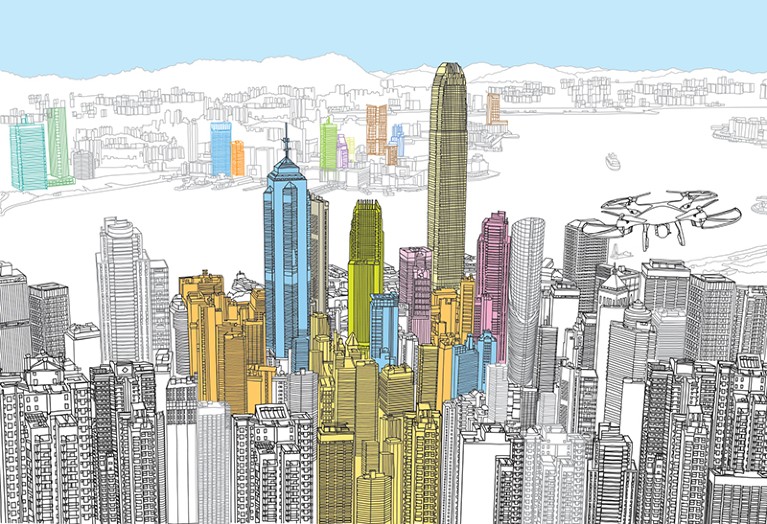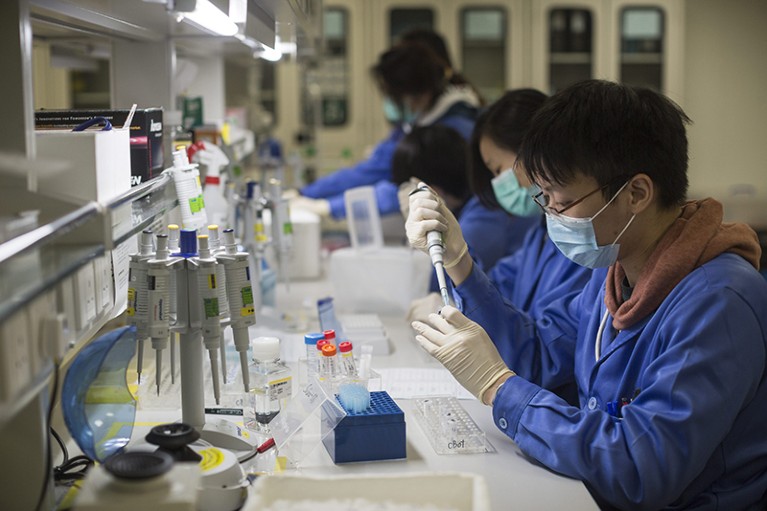
Illustration by Nick Reddyhoff
In March this year, Hong Kong officials earmarked 50 billion Hong Kong dollars (US$6.37 billion) for investment in scientific and technological innovation. The move signalled a desire for tighter connections with China’s new science-based economy, and wish to diversify Hong Kong’s own.
Stephen Phillips runs a government department called InvestHK that promotes investments into the territory from the rest of the world. He hailed the budget announcement as “tangible evidence of the government’s determination to position Hong Kong well in a very competitive landscape”.
This is a divergence from the history of the region. Since 1997, when the UK government returned the territory to China after its 99-year lease expired, Hong Kong has relied mainly on the historic strengths of its banking and property sectors to drive its economy (it has the world’s least-affordable housing market). This has left it vulnerable to shifting economic tides such as the 1997 Asian financial crisis. The rest of China, meanwhile, pivoted towards science and technology to bolster its economy, which was previously known for low-cost manufacturing on a vast scale.
Shenzhen, for example, a city just to the north of Hong Kong, which itself sits on a narrow peninsula in the Guangdong province of southern China, currently commits more than 4% of its gross domestic product (GDP) to research and development (R&D), much of that from private companies. Shenzhen is home to vast science firms, including BGI, the world’s largest genomics company, and DJI, the world’s market leader in drone technology. Hong Kong dedicated only 0.79% of its GDP to R&D in 2016.
Increasingly, collaboration with the mainland, especially Shenzhen and the surrounding metropolitan area, is the key to maintaining Hong Kong’s economic strength in the future, says Matthew Evans, who runs the faculty of science at Hong Kong University.
The Pearl River Delta, of which the territory is a part, is home to 66 million people. The region is named after the eponymous waterway that splits the area in half and forms Hong Kong island. “If you lift Hong Kong out and put it in the middle of the Pacific Ocean, will it still perform? Obviously not,” explains Andrew Leung, a business consultant on Chinese issues, who is based in the city. “Hong Kong must link to somewhere.”
Before the increased budget, Hong Kong had already had some success in science through its existing infrastructure. Last month, for instance, the company SenseTime was crowned the world’s most valuable artificial-intelligence (AI) start-up, following an investment from Alibaba, the e-commerce giant, of more than US$600 million.
Originally conceived at the Chinese University of Hong Kong (CUHK), SenseTime transferred into the territory’s Science Park system, a government-financed incubator that offers subsidized benefits to start-ups.
SenseTime’s speciality is using AI technology for facial recognition, and is regularly criticized by privacy campaigners. In the mega-metropolis of Guangzhou, also part of the Pearl River Delta, this method is used by local police to track the faces of suspected criminals. The company says it has helped to solve at least 100 cases in the city.
As well as the budget announcement, Leung highlights other movements to spur scientific research in the territory in recent years, including the opening of the Innovation and Technology Bureau. It was established in 2015 and is headed by Nicholas Yang, who was formerly vice-president of Hong Kong Polytechnic University. “The question,” says Leung, “is how to marry research with businesses.”
Ways to collaborate
Of the 50 billion Hong Kong dollars from the city’s budget, 20 billion will be spent developing a physical manifestation of the spirit of collaboration. The Lok Ma Chau loop — an area of farmland between Shenzhen and Hong Kong — has been tagged by both cities’ officials as the site of a science and technology park. Officials say the park will be four times the size of current facilities, and it will be managed by the Innovation and Technology Bureau. Feedback is varied: critics have labelled it a government scheme to buy and develop property rather than anything truly committed to promoting R&D.
Others disagree. Representatives for the science park declined to be interviewed for this article, but from 2016 to 2017 the number of start-ups enrolled in its incubator programme, which offers technical and professional support and subsidized rents to science businesses, increased by 8.4% from the one-year period before.
Biochemist Vasu Saini, who moved to the city from India in 2016 to start his PhD at Hong Kong University of Science and Technology (HKUST), says he can see the value of the science park when he considers the jobs available to his peers. “Hong Kong is driven mostly by the economic sector so there are not a lot of jobs for scientists,” he says. “But now there’s a science park, there are more opportunities for people with that background.”
Collaborative spirit
In 2010, BGI established a facility in Hong Kong to supplement its existing sites in Shenzhen and form the basis of a collaboration with CUHK. This was a welcome addition to the employment landscape for some. “I didn’t really know if I could find a science job in Hong Kong at first, but there are a lot of new companies and there’s a lot of new science here,” says Irene Chik, who was born in Hong Kong, and manages a lab in the facility. Her family emigrated to Canada in 1996 and she returned to Hong Kong in 2013.
Academic work is also crossing territorial and cultural borders. Although Hong Kong has five universities in the top 100 QS rankings for 2018, “there’s not normally much of a market for the basic research that Hong Kong universities conduct”, says Naubahar Sharif, who researches innovation and technology policy at HKUST. He says that collaboration with companies elsewhere in China might help to transfer that basic research into commercial applications, and he adds that collaboration with Shenzhen “allows the university sector in Hong Kong to have an outlet”.
One example of this comes from DJI, which was founded in 2006 and, like SenseTime, was conceived in a Hong Kong university and expanded into Shenzhen when the time came to scale up production. Kei May Lau, an electronics engineer at HKUST, worked in the lab next door to robotics engineer Zexiang Li, who was an early adviser and investor at DJI. One day, Li showed her some of the images he’d taken with a drone he’d made with Frank Wang — now the billionaire chief executive of DJI. The company’s drones have become ubiquitous worldwide, especially in film-making and photography. “There were these scenic mountains that they climbed up” and flew the drone over, says Lau. “I said, ‘Wow’. In the old days, if National Geographic wanted to do this, they’d have to spend thousands of dollars on a helicopter to get there. Now, they can take everything they need in a backpack.”

The China–Hong Kong Nature Science Project in December 2015.Credit: Jerome Favre/Epa/REX/Shutterstock
Other universities are sitting up and taking notice of these and other commercial successes, and a rush to work with Chinese collaborators is starting in earnest, partially facilitated by incentives from the government in mainland China to encourage collaboration through the Hong Kong–Shenzhen border and across academic–industry barriers. These include giving researchers access to federal funds previously unavailable to scientists in Hong Kong, a development publicized in Chinese state media this month. An older scheme to share the costs and results of applied research with private-sector partners is another positive.
Lau says that this has resulted in funding in Hong Kong being skewed towards applied research. One of her projects is funded by the Innovation and Technology Bureau, which insists that scientists must match their funding with the same amount of investment from the private sector. “They want to make sure you’re not doing pie-in-the-sky research,” she says.
Companies in China and universities in Hong Kong can both find natural benefits in collaboration, says Sharif. “Shenzhen and the nine or so other cities in the Pearl River Delta have been called the workshop of the world, and they have expertise in manufacturing which Hong Kong doesn’t — but Hong Kong has these world-class universities which the delta doesn’t have.”
Evans sees the advantages for institutions such as his own, but says that any significant collaboration will take an investment of time and good faith.
“One of the challenges for this university and for the rest of Hong Kong is to make these collaborations work,” he says. “We’re part of the Pearl River Delta too, and we should be one of the driving forces on the academic side of that. If I have anything to do with it, we will be.”
“That’s only going to work if the academic sector engages with the business sector,” he says. “I’m spending increasing amounts of my time going over into that area, into mainland China, and talking to companies and people there about how we can work together.”
Feeling familiar
Phillips points to Hong Kong’s Western-style legal framework and intellectual-property laws — hangovers from its history as a British colony that were enshrined in the ‘one country, two systems’ agreement drafted in the reunification process with China. Overseas investors are comfortable spending in Hong Kong because it is culturally accessible, he argues, unlike the Chinese mainland, where many feel that the financial risk is too great and the landscape too unfamiliar, and where foreign companies often find themselves mired in bureaucracy. That works both ways. Hong Kong is also a place for Chinese businesses — in science and elsewhere — to internationalize. Vivek Wadhwa, a distinguished fellow at Carnegie Mellon University’s campus in Mountain View, California, and a columnist on scientific innovation, agrees. “The West doesn’t trust Chinese companies. But it does trust Hong Kong’s laws,” he says. “This solves many problems for the West.”
Culturally, too, Hong Kong has draws for Western investment and talent that mainland China lacks. “If I take you and drop you down in most Chinese cities, the road signs to the food to the language to the culture will be overwhelmingly Chinese,” says Evans. “Hong Kong is a more accessible city for westerners.”
David Zweig studies Chinese diplomacy and the country’s efforts to attract researchers at the Center on China’s Transnational Relations at HKUST, which he runs. He says that there are more differences between China and Hong Kong when it comes to their academic sectors. “The level of academic freedom from bureaucratic interference is preferable in Hong Kong. You don’t need to kiss ass to government administrators so much,” he says. He says that returnees, people born in China who studied and worked elsewhere and have since returned, complain that the bureaucrats “have too much power in the mainland; if you want to get access to research money in your first couple of years, it’s not easy.”
There are still barriers to collaboration, however. Wadhwa says that although Hong Kong might have aligned itself with China’s science and technology priorities, this is not necessarily enough to maintain economic growth. “Yes, there might be opportunities to collaborate with places like BGI in Shenzhen,” he says, “but so what? That doesn’t build a new economy for Hong Kong. That’s not true innovation.”
Politics is another barrier to further collaboration and integration. Many of Hong Kong’s citizens remain protective of their rights to vote, publish and march against the government’s interests — rights that those outside the city do not have. The success of data companies such as SenseTime, which critics say will cement China as a surveillance state, does little to alleviate common fears about what life will be like as we approach 2047 — the due date for full integration with China.
Progress
Whatever happens politically, it’s likely that scientists in Hong Kong and the rest of the Pearl River Delta will draw closer together as time goes on — and many in the scientific world generally see this as a positive. “When you look at what’s happening in this neck of the woods, it’s about complementarity,” says Phillips. “It’s not about one city being set up against another. That’s not how businesses see it. They look at how they can deliver business.”
Evans is confident that collaborations across the border will strengthen in academia, too. “We have to work hard to make it happen now,” he says. “If it doesn’t happen now, we’re going to lose our place.” Fortunately, Hong Kong is a city used to swift transformation, Chik says, especially when compared with her previous home of Vancouver. “It’s fast-paced and ever-changing, and if you don’t change fast enough, then all these competitors — they will overtake you.”


 Spotlight on Shenzhen
Spotlight on Shenzhen
 Career guide: China
Career guide: China
 Nature Special: Science in China
Nature Special: Science in China





